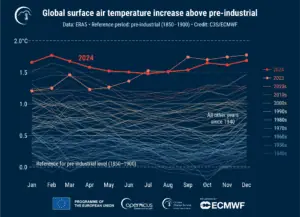Extreme weather: experts urge more preparation
Last week’s news was clearly negative: According to Munich Re, the world’s largest reinsurer, global natural catastrophes caused above-average losses of 320 billion dollars in 2024. Chief climatologist Tobias Grimm blames climate change for this. “The world is hotter than ever before,” he says. And that means stronger storms, severe weather, and flooding.” In terms of insured losses, 2024 was the third most expensive year since 1980, according to Munich Re.
Record temperatures
The Copernicus Climate Change Service promptly reported that 2024 was the warmest year since records began, with climate change also leading to extremely warm ocean temperatures. The German Weather Service had stated that Germany had experienced the hottest year since measurements began. Uwe Kirsche, press spokesman for the DWD, explained: “What is particularly alarming is that 2024 exceeded the previous year by an extraordinary 0.3 degrees. This is accelerated climate change.” The very mild winter of 2023/2024 and the record-breaking warm spring also brought unusually high levels of precipitation.
2024 was clearly too wet a year in Germany. The extreme weather that led to the high losses worldwide hit North America the hardest, but Europe was also affected by severe flooding in Spain, Germany, Austria and other countries.
The consequence for the golf market is clear: both golf courses and the entire infrastructure and buildings on golf courses must be scrutinized in order to prevent damage from occurring in the future in the event of extreme weather incidents. However, if you ask experts for their assessment of the current resilience situation on golf courses in the German-speaking region, the results are rather disappointing. “We didn’t have any major insurance claims in Germany in 2024, but the investment backlog in the building sector in particular is enormous in some cases,” laments insurance expert Robert Paas. “This ranges from incorrectly insulated electrical wiring and dilapidated pipelines to a lack of flood protection.” This investment backlog could ultimately lead to insurance companies leaving the golf market completely in order to avoid high costs.
Subscribe to our newsletter!
News & trends about sustainability in golf
Sven Weinberger, Sales Manager for Rainbird, the world’s leading specialist for irrigation in the golf market, who looks after Germany, Austria, Switzerland and the Netherlands, has a similar view. He notes a maintenance backlog on many systems, which leads to sprinklers, pipes and pumps becoming increasingly dilapidated over time. “At some point, the system is so old that you have to replace it completely. It’s like an old car that no longer passes its MOT. You don’t even change the oil anymore.” However, many smaller golf courses can hardly afford completely new irrigation systems.
According to Weinberger, this situation can be prevented by a consistent maintenance and renovation system. “If you make a plan and replace one to three greens with a new sprinkler system every year, you can prevent everything suddenly having to be replaced.” He also misses the concept of dealing with extreme weather. After all, the irrigation system of a golf course must be able to irrigate with pinpoint accuracy in the event of drought but also quickly remove the water from the fairways in the event of heavy rainfall. “95% of courses are unprepared for extreme weather,” he concludes.
An assessment shared by golf course designer Thomas Himmel. “The issue of drought has taken a back seat at many golf courses over the past two years due to the frequent rainfall,” he notes. “Basically, however, with the help of sufficiently large irrigation ponds in combination with an effective irrigation and drainage system, you have to work to ensure that golf courses function well both with too much and too little water.”
At this point, all three experts agree that a medium—to long-term strategy is needed for both the course and its buildings. “Short-term repairs only lead to greater damage,” Paas points out.
Looking at Munich Re’s claims balance sheet and the balance sheets of the German Weather Service and the Copernicus Climate Change Service, it is not difficult to look to the future. It is impossible to say whether it will be too hot or too wet in Europe or the USA in 2025. One thing is certain: extreme weather is becoming more frequent, and it will cost money if we are not prepared for it.









